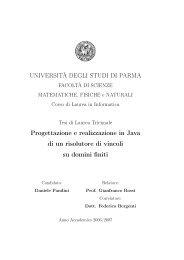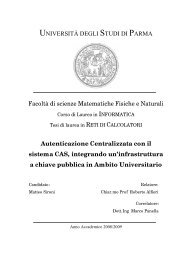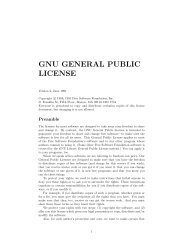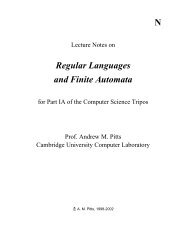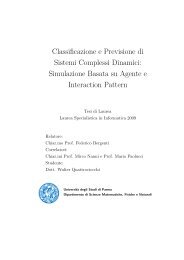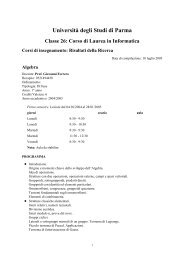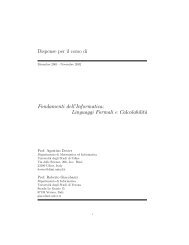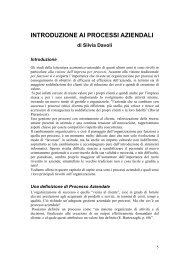A New Look at the Automatic Synthesis of Linear Ranking Functions$
A New Look at the Automatic Synthesis of Linear Ranking Functions$
A New Look at the Automatic Synthesis of Linear Ranking Functions$
- No tags were found...
Create successful ePaper yourself
Turn your PDF publications into a flip-book with our unique Google optimized e-Paper software.
plrf(C) ⊆ svg(C). Let us pick µ ∈ plrf(C). For this choice, <strong>the</strong> correspondingLP problem (10) is bounded by r ≥ 1, so is its dual (11). Let ŷ be an optimalsolution for (11). Thus 〈ŷ, µ〉 is a feasible solution <strong>of</strong> (12) and (13). Henceµ ∈ svg(C).As an immedi<strong>at</strong>e consequence, <strong>the</strong> question “does a given binary recursiveclause with linear constraint admit a positive linear mapping?” can be solvedin weakly polynomial time.Corollary 4.3. Let C be <strong>the</strong> binary CLP(Q + ) clause p(¯x) :− c[¯x, ¯x ′ ], p(¯x ′ ),where c[¯x, ¯x ′ ] is a linear s<strong>at</strong>isfiable constraint. The decision problem plrf(C) = ∅is in P.Pro<strong>of</strong>. By Theorem 4.2 <strong>the</strong> problems plrf(C) = ∅ and svg(C) = ∅ are equivalent.So, if (13) is feasible <strong>the</strong>n <strong>the</strong> answer is no: as c[¯x, ¯x ′ ] is s<strong>at</strong>isfiable, weare in case (2)(b). O<strong>the</strong>rwise, again because <strong>of</strong> <strong>the</strong> s<strong>at</strong>isfiability <strong>of</strong> c[¯x, ¯x ′ ], ei<strong>the</strong>r(10) is unbounded (case (1)(a)ii. or it is bounded by q ′ < 0 (case (1)(b)).In both cases, <strong>the</strong> answer is yes. Finally, testing <strong>the</strong> s<strong>at</strong>isfiability <strong>of</strong> a linearsystem, as well as computing one <strong>of</strong> its solutions —and thus computing oneconcrete linear ranking function—, is in P (see, e.g., [28]).For <strong>the</strong> case where we have more than one directly recursive binary CLP(N)clauses, C 1 , . . . , C n , <strong>the</strong> set <strong>of</strong> global positive linear ranking functions, i.e., th<strong>at</strong>ensure termin<strong>at</strong>ion whichever clause is selected <strong>at</strong> each comput<strong>at</strong>ion step, isgiven by ⋂ ni=1 svg(C i). This can be computed by taking <strong>the</strong> conjunction <strong>of</strong> <strong>the</strong>constraints obtained, for each clause, from <strong>the</strong> projection <strong>of</strong> <strong>the</strong> constraints <strong>of</strong><strong>the</strong> corresponding linear problem (13) onto µ.To summarize, <strong>the</strong> main contribution <strong>of</strong> Sohn and Van Gelder lies in <strong>the</strong>irencoding <strong>of</strong> <strong>the</strong> ranking function search problem into linear programming and<strong>the</strong>ir use <strong>of</strong> <strong>the</strong> duality <strong>the</strong>orem. As we will see, this idea is amenable to ageneraliz<strong>at</strong>ion th<strong>at</strong> makes it widely applicable to any programming paradigm,not just (constraint) logic programming.4.2. The Generaliz<strong>at</strong>ion by Mesnard and SerebrenikFred Mesnard and Alexandre Serebrenik have generalized <strong>the</strong> method <strong>of</strong>Sohn and Van Gelder from <strong>the</strong> analysis <strong>of</strong> logic programs to <strong>the</strong> analysis <strong>of</strong>CLP(Q) and CLP(R) programs in [17, 18]. In <strong>the</strong> following, for present<strong>at</strong>ionpurposes and without loss <strong>of</strong> generality, we consider <strong>the</strong> case <strong>of</strong> r<strong>at</strong>ional-valuedvariables. They use a class <strong>of</strong> affine ranking functions <strong>of</strong> <strong>the</strong> formf p (y 1 , . . . , y n ) = µ 0 +n∑µ i y i , (15)where µ i ∈ Q, for i = 0, . . . , n. Allowing for r<strong>at</strong>ional-valued coefficients µ i andvariables y i (both <strong>the</strong> µ i ’s and <strong>the</strong> y i ’s were n<strong>at</strong>urals in [7]) implies th<strong>at</strong> (15)i=116



